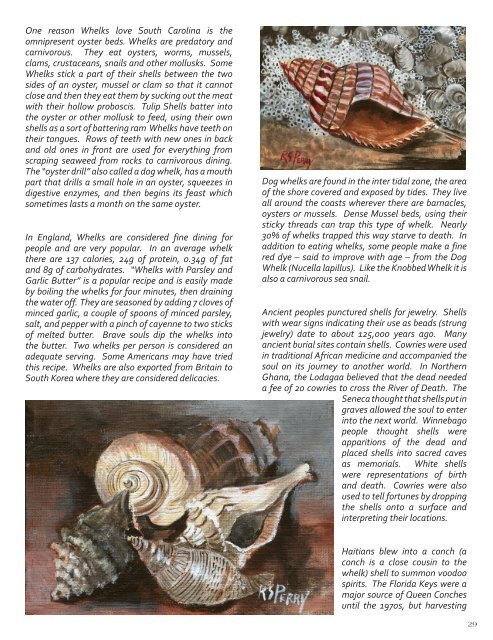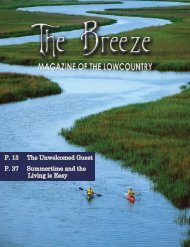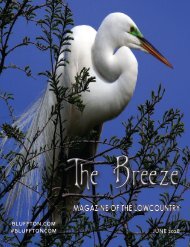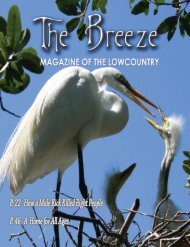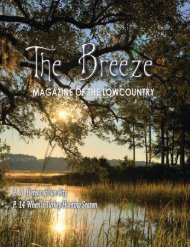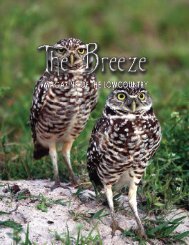The Breeze Magazine of the Lowcountry JUNE 2020
Create successful ePaper yourself
Turn your PDF publications into a flip-book with our unique Google optimized e-Paper software.
One reason Whelks love South Carolina is <strong>the</strong><br />
omnipresent oyster beds. Whelks are predatory and<br />
carnivorous. <strong>The</strong>y eat oysters, worms, mussels,<br />
clams, crustaceans, snails and o<strong>the</strong>r mollusks. Some<br />
Whelks stick a part <strong>of</strong> <strong>the</strong>ir shells between <strong>the</strong> two<br />
sides <strong>of</strong> an oyster, mussel or clam so that it cannot<br />
close and <strong>the</strong>n <strong>the</strong>y eat <strong>the</strong>m by sucking out <strong>the</strong> meat<br />
with <strong>the</strong>ir hollow proboscis. Tulip Shells batter into<br />
<strong>the</strong> oyster or o<strong>the</strong>r mollusk to feed, using <strong>the</strong>ir own<br />
shells as a sort <strong>of</strong> battering ram Whelks have teeth on<br />
<strong>the</strong>ir tongues. Rows <strong>of</strong> teeth with new ones in back<br />
and old ones in front are used for everything from<br />
scraping seaweed from rocks to carnivorous dining.<br />
<strong>The</strong> “oyster drill” also called a dog whelk, has a mouth<br />
part that drills a small hole in an oyster, squeezes in<br />
digestive enzymes, and <strong>the</strong>n begins its feast which<br />
sometimes lasts a month on <strong>the</strong> same oyster.<br />
In England, Whelks are considered fine dining for<br />
people and are very popular. In an average whelk<br />
<strong>the</strong>re are 137 calories, 24g <strong>of</strong> protein, 0.34g <strong>of</strong> fat<br />
and 8g <strong>of</strong> carbohydrates. “Whelks with Parsley and<br />
Garlic Butter” is a popular recipe and is easily made<br />
by boiling <strong>the</strong> whelks for four minutes, <strong>the</strong>n draining<br />
<strong>the</strong> water <strong>of</strong>f. <strong>The</strong>y are seasoned by adding 7 cloves <strong>of</strong><br />
minced garlic, a couple <strong>of</strong> spoons <strong>of</strong> minced parsley,<br />
salt, and pepper with a pinch <strong>of</strong> cayenne to two sticks<br />
<strong>of</strong> melted butter. Brave souls dip <strong>the</strong> whelks into<br />
<strong>the</strong> butter. Two whelks per person is considered an<br />
adequate serving. Some Americans may have tried<br />
this recipe. Whelks are also exported from Britain to<br />
South Korea where <strong>the</strong>y are considered delicacies.<br />
Dog whelks are found in <strong>the</strong> inter tidal zone, <strong>the</strong> area<br />
<strong>of</strong> <strong>the</strong> shore covered and exposed by tides. <strong>The</strong>y live<br />
all around <strong>the</strong> coasts wherever <strong>the</strong>re are barnacles,<br />
oysters or mussels. Dense Mussel beds, using <strong>the</strong>ir<br />
sticky threads can trap this type <strong>of</strong> whelk. Nearly<br />
30% <strong>of</strong> whelks trapped this way starve to death. In<br />
addition to eating whelks, some people make a fine<br />
red dye – said to improve with age – from <strong>the</strong> Dog<br />
Whelk (Nucella lapillus). Like <strong>the</strong> Knobbed Whelk it is<br />
also a carnivorous sea snail.<br />
Ancient peoples punctured shells for jewelry. Shells<br />
with wear signs indicating <strong>the</strong>ir use as beads (strung<br />
jewelry) date to about 125,000 years ago. Many<br />
ancient burial sites contain shells. Cowries were used<br />
in traditional African medicine and accompanied <strong>the</strong><br />
soul on its journey to ano<strong>the</strong>r world. In Nor<strong>the</strong>rn<br />
Ghana, <strong>the</strong> Lodagaa believed that <strong>the</strong> dead needed<br />
a fee <strong>of</strong> 20 cowries to cross <strong>the</strong> River <strong>of</strong> Death. <strong>The</strong><br />
Seneca thought that shells put in<br />
graves allowed <strong>the</strong> soul to enter<br />
into <strong>the</strong> next world. Winnebago<br />
people thought shells were<br />
apparitions <strong>of</strong> <strong>the</strong> dead and<br />
placed shells into sacred caves<br />
as memorials. White shells<br />
were representations <strong>of</strong> birth<br />
and death. Cowries were also<br />
used to tell fortunes by dropping<br />
<strong>the</strong> shells onto a surface and<br />
interpreting <strong>the</strong>ir locations.<br />
Haitians blew into a conch (a<br />
conch is a close cousin to <strong>the</strong><br />
whelk) shell to summon voodoo<br />
spirits. <strong>The</strong> Florida Keys were a<br />
major source <strong>of</strong> Queen Conches<br />
until <strong>the</strong> 1970s, but harvesting<br />
29


